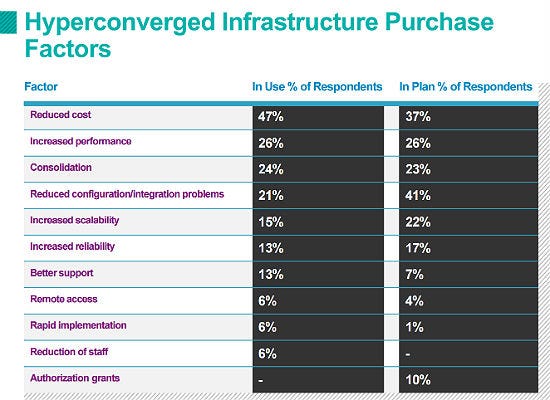5 Ways Hyperconverged Infrastructure Increases Partner Profitability5 Ways Hyperconverged Infrastructure Increases Partner Profitability
Transforming customer data centers with HCI pays off for their businesses and your bottom line.
January 4, 2017

 Hyperconverged infrastructure, or HCI, is now the biggest segment of the software-defined storage market, with IDC attributing growth to lower costs, more flexibility and better ease of management versus traditional storage systems. (Not familiar with HCI? See my write-up here.)
Hyperconverged infrastructure, or HCI, is now the biggest segment of the software-defined storage market, with IDC attributing growth to lower costs, more flexibility and better ease of management versus traditional storage systems. (Not familiar with HCI? See my write-up here.)
In fact, a recent study from TechTarget Research identified HCI as one of the top two technology “momentum drivers” for data-center owners, just behind hybrid cloud. Close to half of current HCI users say they’ve reduced costs.
What does that mean for the channel?
Because hyperconverged systems are based on industry-standard servers, some partners worry that profitability will not match traditional storage offerings. That needn’t be the case, and here are five reasons why partners can safely expect HCI profitability to compare favorably with conventional storage arrays.
Reason #1: HCI sales cycles are 4x faster than classic storage.
Most buyers expect a traditional storage array to sit unchanged for years. They spend up to a year before buying, trying to align unknowable future needs with today’s budget realities. With HCI, users can start small and scale out with future-proofed designs. With more flexibility and lower entry costs, I see deals getting done in 60-90 days, with a repeat buy pattern that cements ongoing customer purchases and partner loyalty over time.

Reason #2: HCI consolidates partner training time and cost.
Hyperconverged systems don’t simply integrate servers and scale-out storage. HCI also consolidates partner training time since management of servers and scale-out storage is based on widely used (or popular) server- and virtualization-management tools. And, most HCI offerings are available from multiple server vendors, so partners can offer customers a choice of suppliers without introducing new user interfaces or management silos.
Reason #3: HCI introduces value-added data protection services.
While standalone server sales deliver limited services and support revenues, you can make the case for a services contract to support virtual environments running mission-critical applications with high-value data. I see new opportunities to introduce value-added services around data backup, archiving and recovery.
Reason #4: HCI helps maximize partner program dollars .
Partners looking to maximize market development dollars can use HCI to drive programs supported by their largest partners. By adding HCI to a line card, you can expand the size and scope of registered deals with both existing server suppliers and newer HCI vendors. This is an excellent hedge strategy for partners looking to counter the shrinking legacy enterprise storage market.
Reason #5: HCI may lower the cost of delivering support.
HCI systems minimize the risk of misconfiguration because of their flexible scale-out design. They also minimize performance risk because they make flash affordable. A growing number of HCI systems are already all-flash, further eliminating upfront configuration time, minimizing on-site performance tuning and improving customer satisfaction.
John Naisbitt, a long-time business analyst, once said, “Leadership involves finding a parade and getting in front of it.” HCI is a fast-moving parade that offers savvy partners a profitable present and future during a time of great change.
Lee Caswell is VP of products, storage and availability business unit, VMware. He leads a team driving storage that speeds the customer adoption of new products, partnerships, and integrations. Lee joined VMware in 2016 and has extensive experience in executive leadership within the storage, flash and virtualization markets. He has a long history of promoting flash adoption as vice president of marketing at NetApp and vice president of solution marketing at Fusion-IO (now SanDisk).
Read more about:
AgentsAbout the Author
You May Also Like


